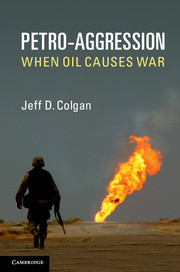Book contents
- Frontmatter
- Contents
- Figures
- Tables
- Acknowledgments
- 1 Introduction
- 2 A theory of oil, revolution, and conflict
- 3 Evidence and research design
- 4 Quantitative impact of oil and revolution on conflict
- 5 Iraq
- 6 Libya and the Arab Jamahiriyya
- 7 Iran
- 8 Venezuela and the Bolivarian Revolution
- 9 Saudi Arabia
- 10 Does oil cause revolution?
- 11 Conclusion and policy implications
- References
- Index
5 - Iraq
Published online by Cambridge University Press: 05 February 2013
- Frontmatter
- Contents
- Figures
- Tables
- Acknowledgments
- 1 Introduction
- 2 A theory of oil, revolution, and conflict
- 3 Evidence and research design
- 4 Quantitative impact of oil and revolution on conflict
- 5 Iraq
- 6 Libya and the Arab Jamahiriyya
- 7 Iran
- 8 Venezuela and the Bolivarian Revolution
- 9 Saudi Arabia
- 10 Does oil cause revolution?
- 11 Conclusion and policy implications
- References
- Index
Summary
The Revolution chooses its enemies.
– Saddam HusseinIn a double coup in July 1968, Saddam Hussein came to power at the right hand of Hasan al-Bakr, the secretary-general of the Baathist Party and new president of Iraq. The events of July 1968 were only the latest in a period of extraordinary political tumult in Iraq, beginning with the overthrow of the monarchy and establishment of a republic in 1958. Still more political changes were to come. By the end of the 1970s, Saddam Hussein had displaced al-Bakr and transformed his country politically, economically, and socially using an enormous influx of oil revenues. Saddam’s strategy, based on the twin forces of patronage and fear, was in its essence as simple as it was ruthlessly effective. With Saddam in power, Iraq was to become one of the most aggressive states of the twentieth century.
The principal aim of this chapter is to evaluate the extent to which Iraq’s behavior is explained by the theory described in Chapter 2. The first step in testing the theory is to consider the value of the key variables for each time period under analysis, exploiting the variation over time. If my theory is correct, the actual behavior of Iraq should match the theory’s predictions based on the explanatory variables. Table 5.1 below provides a brief summary of the key variables: the aggressiveness of the state’s foreign policy, the presence of revolutionary government, and the presence of oil income.
- Type
- Chapter
- Information
- Petro-AggressionWhen Oil Causes War, pp. 90 - 122Publisher: Cambridge University PressPrint publication year: 2013

